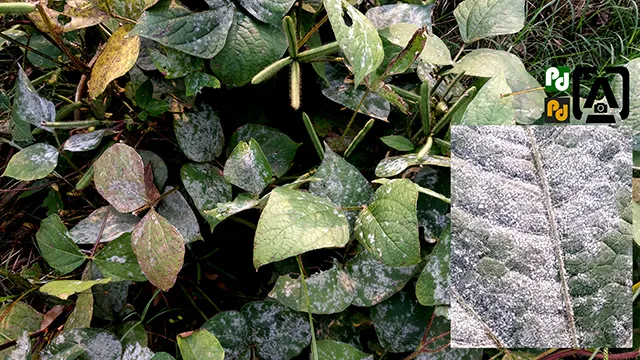Powdery mildew of black gram
Host: Vigna mungo (Black gram/Urad daal)
Pathogen: Erysiphe polygoni DC
Pathogen: Erysiphe polygoni DC
Distribution
Powdery mildew is one of the most economically significant diseases of black gram. The disease has world-wide occurrence, wherever black gram is cultivated. This disease mostly appear in warm and humid atmosphere. Black gram is cultivated in all seasons and most of the infection occurs during winters. It can severely reduce the yield of black gram.
Symptoms
 |
| Plants of black gram showing powdery mildew (note the white cottony mass on leaf in inset) |
Initial symptom appear in the form of small patches of white superficial growth on the surface of shaded leaves. Eventually, whole the leaf surface (some times both surfaces) is covered by white mass of mycelia and spores. At maturity the fungal mass is converted to cream color appearance. If not treated, fungal growth covers all the leaves, petioles, pods and twigs. As pathogen reduces the photosynthetic surface area and suck the nutrition from the leaves, size of pods and number of seed in a pod are significantly reduced.
Causal organism
Powdery mildew of black gram is caused by Erysiphe polygoni DC. It is an ascomycetous fungus with superficial growth (ectophytic) on the host surface. The pathogen is a biotroph and produces haustoria inside the living epidermal cells and draw nutrition.
 |
| Erysiphe polygoni on Black gram. a & b: Conidiophores bearing chain of conidia, c: haustoria inside the cells, d: elliptical as well barrel shaped conidia, e: chain of conidia and condiophores in surface view (photographs not on the scale) |
It reproduces by means of asexual spores as well as cleistothecium. Conidiophores arise at right angle to the host epidermal cells and bear single chain of conidia. Conidia are single-celled, hyaline and thin walled elliptical to barrel shaped.
At the end of the host season minute, black globose cleistothecia appear, which have myceloid appendages. Each cleistothecium contains 4-8 asci. Each ascus contains 3-8 elliptical, hyaline ascospores.
At the end of the host season minute, black globose cleistothecia appear, which have myceloid appendages. Each cleistothecium contains 4-8 asci. Each ascus contains 3-8 elliptical, hyaline ascospores.
Disease cycle and epidemiology
The disease is soil borne and polycyclic. Cleistothecia are perenating structures. These cleistothecia survive in the debris and infect new plants causing primary infection. The secondary infection takes place by means of conidia produced in the same crop season. Conidia are spreaded by means of rain splashes as well as by field workers.
Control measures
- Field sanitation is necessary. Destroy any debris in the field before sowing black gram.
- Raise powdery mildew resistant varieties.
- Spray Carbendazim 500 g or Wettable sulfur 2 kg or Tridemorph 500 ml/ha on appearance of first symptom. Repeat the treatment after 15 days.
- Practice crop rotation with non-leguminous crops.
Content first created on 23-10-2021
last updated on 27-10-2021
last updated on 27-10-2021





0 Comments
Leave your comments here.